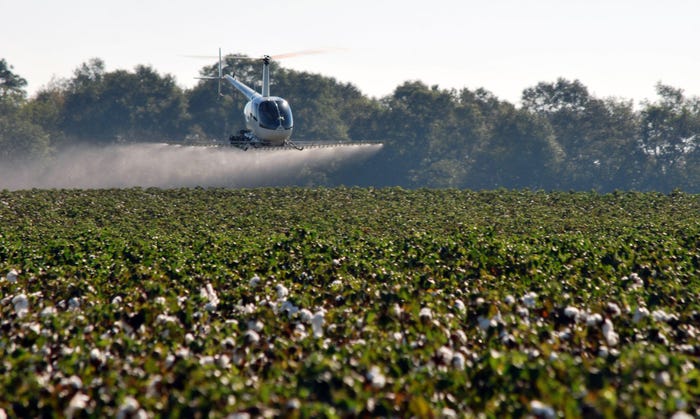
The cotton crop in the Deep South is later than normal. Weather didn't cooperate. But there's time to thread the needle on timely aggressive harvest aids to grab more quality yield from some fields.
Due to weather challenges in late spring, "we probably had more replanting than I've ever seen in North Alabama (and Tennessee Valley)," said Tyler Sandlin, an Alabama Cooperative Extension Service agronomist, speaking at the annual University of Tennessee Cotton Field Day in Jackson, Tenn., Sept. 1.
"So, that has pushed us pretty late on the crop and will make some decisions on defoliation and mixes a little more challenging this year as we get into some of those cooler temperatures later," he said.
Most growers know how they are going to time defoliation, he said, whether using the method of percent-of-opening-nodes above cracked node or the 'sharp knife' method.
(For reminder, when a 1st position boll is cracked, and there are bolls four to five nodes above that one, they are generally mature enough to hit with a harvest aid application.)
He said a lot of Sept. 1 cotton looked too much like what Aug. 1 cotton would look like in a more weather-friendly growing season. Growers were hoping for a September filled with more sunshine and less clouds, but so far as of the week of Sept. 20, that didn't happen for much of Alabama. There will be some borderline decisions to be made this year.
"I think this year, we need to be slicing open more bolls," he said. "There's a lot of green left on this crop."
(A sharp knife cutting a cross section of a mature boll will string fiber out and show seed with well-formed cotyledons and seed coats yellow, tan or dark brown. A sliced immature boll will have jelly-like seed and clearer seed coats.)

Unopened cotton bolls as late as the middle of October can still reach harvestable maturity by November in some seasons. In this file photo, cotton harvest aids are being applied by helicopter.
Growers can be optimistic about what they can harvest out of upper material bolls, he said, but they must be realistic, too. He cited some work by Tyson Raper, UT Extension cotton agronomist. Later bolls often can mature faster than earlier bolls when sunshine and heat cooperate. Unopened bolls as late as the middle of October can still reach harvestable maturity by November in some seasons. In this scenario, laying off the defoliation trigger can help put more seed cotton at the gin.
He said growers comfortable with their timing on defoliation and harvest aid mixes should stick with what works for them and their pocketbooks, but they shouldn't be afraid to be aggressive as they push into cooler weather this year. He shared one Alabama grower's defoliation 'boo-boo' from last year that turned out not to be one. The grower's one of the best in the area and easy to work with, but things happen.
Last year at defoliation time, upper Alabama was unseasonably cool with nighttime temperatures hitting 50s and even mid-40s with daytime temperatures in the 60s. The grower's applicator put out the defoliant while the grower was out of town. They figured out later that the application included 13 ounces of Cutout to the acre, 10 ounces of Folex, and about 40 ounces of Ethephon (a boll-opening material). The grower feared he'd fried everything. "This is not a rate recommendation we’d make even with those conditions," Sandlin said.
The grower intended to use 6 ounces of Cutout, 10 ounces of Folex and 40 ounces of Ethephon, a mix that was doing well for growers in the area given the conditions.
Sandlin and the grower walked the fields later. The grower had not fried everything. And just like many other growers in the area, he had to come back in the field to touch up with ET or Aim to knock out regrowth and some of the “skirt,” Sandlin said.
"That said, don't be afraid to be aggressive to try to get as much off and as much open as you can. And if a grower has to come back and touch up, that's OK, and some of growers already do a planned second pass. Ultimately, they need to do what works out for them," he said.
The USDA September crop report forecasts Alabama cotton growers to average 924 pounds per acre on 400,000 harvested acres.
For more details and recommendations, check out 'Application of Cotton Defoliation Aids in Alabama.'
Read more about:
DefoliationAbout the Author(s)
You May Also Like






